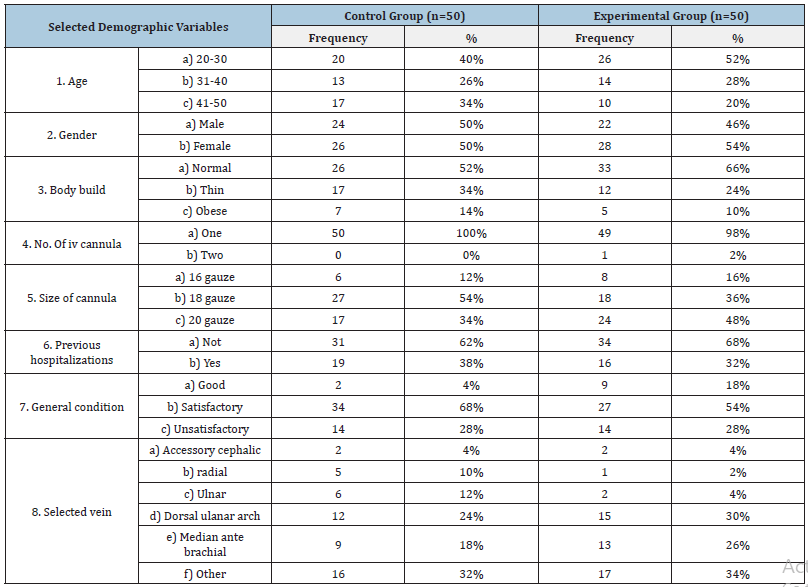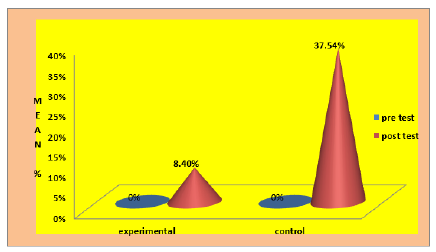- Submissions

Full Text
COJ Nursing & Healthcare
Contrast Hydrotherapy in Reducing the Risk of Thrombophlebitis Among the IV Cannulated Patient In Selected Hospital at Vijayapur
Chetan S Patali1*, Sankappa Gulaganji2, Meenaxi Madabhavi3 and Manjunath Patil4
1Principal Tatwadarsha Institute of Nursing Sciences Hubballi, India
2Associate Professor BLDEA’s Shri B M Patil Institute of Nursing Sciences, Vijayapur, India
3Nursing Officer, Vijayapur, India
4Assistant Professor BLDEA’s Shri B M Patil Institute of Nursing Sciences, Vijayapur, India
*Corresponding author: Chetan S Patali, Principal Tatwadarsha Institute of Nursing Sciences Hubballi, India
Submission: March 14, 2023Published: April 10, 2023

ISSN: 2577-2007Volume8 Issue3
Abstract
Objective: Intravenous catheters have been indispensable tools of modern medicine. Although intravenous
applications can be used for a multitude of purposes, these applications may cause complications, some
of which have serious effects. Among these complications, the most commonly observed is phlebitis. This
study was conducted to determine the observation on developing thrombophlebitis among IV cannulated
patients in experimental and control groups and to evaluate the effectiveness of contrast hydrotherapy in
reducing the risk of developing thrombophlebitis among the experimental group.
Methods: This study determined the effect of contrast hydrotherapy to reduce the risk of thrombophlebitis.
The study included a total of 100 individuals who were admitted to the medical and surgical ward and
satisfied the study enrollment criteria in Vijayapur/India. Data were compiled from Patient Information
Forms and patient, Peripheral Intravenous Catheter and Therapy Information Forms, reported grades
based on the Visual Infusion Phlebitis Assessment Scale, and Peripheral Intravenous Catheter Nurse
Observation Forms. The data were analyzed using SPSS.
Results: The result shows that the mean pre-test score of the experimental group was 0. The mean posttest
score was 0.424±0.70048. The findings were significant as computed p=0.000 and ‘t’ value 4.248 at
0.01 level of significance. The mean post-test score of the experimental group 0.424±0.70048 was lower
than the mean post-test score of the control group 1.1599±1.87848. The computed p=0.000 and ‘t’ values
were 4.469 at 0.01 level of significance.
Conclusion: The study concludes that contrast hydrotherapy was effective for reducing the risk of
thrombophlebitis.
Keywords: Contrast; Hydrotherapy; Thrombophlebitis; IV cannula; Effectiveness
Introduction
The peripheral venous catheter is the common and essential intravenous device frequently used in medical practices [1]. The more than 80% of the patients who are admitted to the hospital are cannulated with IV cannula to meet with their daily therapeutic and nutritional requirement. When the patient comes to hospital for treatment, the intra venous therapy are used to administer the medication, intra nutritional support and also blood and blood product. Approximately 60% of hospital inpatients annually undergo peripheral intravenous cannulation to receive therapeutic IV medication [2]. The commonest complication of this IV cannulation is superficial thrombophlebitis including abnormalities of coagulation or fibrinolysis, endothelial dysfunction, infection, venous stasis, intravenous therapy and intravenous drug abuse. (Waitt C, Waitt P, et.al, 2004). To prevent needle stick injury nurses should follow proper guidelines [3] and Clinical evaluation is the primary diagnostic tool for thrombophlebitis. It can be examined when the skin over the affected vein exhibits erythema, warmth, swelling and tenderness. Thrombophlebitis can be classified as either superficial or deep; in about 55% of all patients receiving IV therapies develops superficial thrombophlebitis and at least in 5% of all surgical patients develop deep vein thrombophlebitis which has an estimated frequency of 1 in 1000 persons a year (Suzanne C Smeltzer, Brenda G, 2010).
History
Hydrotherapy is almost as old as the hills from which the water runs. In fact, it has been historically accounted for in a number of ancient civilizations [4]. Although it serves as a safe, effective and inexpensive treatment, hydrotherapy in modern times is often overlooked as a powerful healing tool. (Michigan, Battle Creek, 2009)
Review of Literature
Chinnamma Verghese (2010) conducted a study on prevention and reduction of pain bruise and hematoma by “moist ice pack” application on the site of subcutaneous heparin injection. The sample size consists of 100 injection sites each in the experimental and control group respectively. Recognizing the physiological responses of the cell/tissue to injury or trauma, the “moist ice pack” procedure was performed for 5 minutes at the subcutaneous heparin injection site twice daily for three days in the experimental group. Assessment of pain, bruise and hematoma were carried out at 12, 48 and 72 hours in both the groups. Results were statistically significant in favor of the use of moist ice pack while comparing the pain and bruise at subcutaneous injection site between experimental and control group at 12, 48 and 72 hours in the current study (p lessthan 0.05 and p lessthan 0.01).
Vishwambaran N (2010) an interventional study was conducted in Mangalore on effectiveness of ice packs versus thrombophobe gel for reducing intra venous infiltration in patients admitted in pediatric wards. The study was conducted on 40 samples (20 for thrombophobe gel group and 20 for ice cube group) selected using purposive sampling technique. The infiltration was assessed by using a modified infiltration scale. The results showed that before the treatment, the majority (65%) of patients had grade two infiltrations after the treatment with thrombophobe and 100% of patient’s infiltration had reduced to grade one infiltration. In group two majorities (80%) had grade two infiltrations after the treatment with ice cube 100% had grade one infiltration. The study concluded that both thrombophobe gel and ice pack are effective in reducing intravenous infiltration among pediatrics patients [5-9].
Statement of the problem
“Contrast hydrotherapy in reducing the risk of thrombophlebitis among the IV cannulated patient in selected hospital at Vijayapur”.
Objectives of the study
A. To determine the observation on developing
thrombophlebitis among IV cannulated patient in experimental
and control group.
B. To evaluate the effectiveness of contrast hydrotherapy in
reducing the risk of developing thrombophlebitis among the
experimental group.
C. To compare the effectiveness of contrast hydro therapy
in reducing risk of developing thrombophlebitis with
experimental group and control group.
D. To find out the association between reduction in the risk
of developing thrombophlebitis and selected demographic
variables among the experimental group and control group
Hypothesis: [at 0.01 level of significance]
H01: There is no significant difference between reduction in the risk of developing the thrombophlebitis among the experimental group and control group among the IV cannulated patient. H1: There is a significant difference between reduction in the risk of developing the thrombophlebitis among the experimental group and control group among the IV cannulated patient. H02: There is a no significant association between post test score in risk of developing the thrombophlebitis with selected demographic variables in the experimental group and the control group among the IV cannulated patient; H2: There is a significant association between post test score in risk of developing the thrombophlebitis with selected demographic variables in the experimental group and the control group among the IV cannulated patient;
Research methodology
The quantitative evaluative study was conducted using qusiexperimental research design at selected hospital of Vijayapur. The total sample size was 100 samples. Before conducting the study written consent were obtained from the sample. The purposive sampling technique was used. on day one the data collection was by using demographic tool with VIP scale for pretest control group and experimental group after that researcher was given intervention to the experimental group for three times in a day for three days then posttest was taken by the researcher duration of the average time taken .
Results
The researcher found the existing problems of thrombophlebitis by use of visual infusion phlebitis scale (Table 1 & 2). The mean pretest score of experimental and control group was 0, which shows that all subjects were at same stage 0, i.e., no sign and symptom of thrombophlebitis (as observed by VIP scale) in both groups. The mean post test score of experimental group 0.424±0.70048was lower than mean post test score 1.1599±1.87848 of control group (Figure 1). The mean percentage of post test score of experimental group was 8.4% and 37.54% was of control group. The mean pretest score of the experimental group was 0. The mean post test score was0.424±0.70048. The findings were significant as computed p=0.000 and ‘t’ value 4.248 at 0.01 level of significance. The mean post test score of experimental group 0.424±0.70048 was lower than mean post test score of control group 1.1599±1.87848. The computed p=0.000 and ‘t’ value was 4.469 at 0.01 level of significance.
Table 1:Subject according to demographic characteristics by frequency and percentage (n=100).

Table 2:Visual infusion phlebitis score in experimental and control group N=100.

Figure 1:Graph showing mean percentage of pretest and posttest VIP score of experimental and control group.

Conclusion
Analysis and interpretation of data were done based on the objectives of the study and hypothesis to be tested. Both the descriptive and inferential statistics were used. The study concludes that contrast hydrotherapy were effective for reducing the risk of thrombophlebitis.
Recommendation
A. The same study could be undertaken in large samples
B. A similar study can be replicated for other hospital.
C. The study could be undertaken in alternative method for
prevention of thrombophlebitis.
References
- Webster J, Osborne S, Rickard CM, Marsh N (2019) Clinically-indicated replacement versus routine replacement of peripheral venous catheters. Cochrane Database of Systematic Reviews 1(1): CD007798.
- Osti C, Khadka M, Wosti D, Gurung G, Zhao Q (2019) Knowledge and practice towards care and maintenance of peripheral intravenous cannula among nurses in Chitwan medical college teaching hospital, Nepal. Nursing Open 6(3): 1006-1012.
- Sankappa G (2016) Knowledge regarding needle stick injury among student nurses. Journal of Nursing Science & Practice 6(1): 39-42.
- Gianfaldoni S, Tchernev G, Wollina U, Roccia MG, Fioranelli M, et al. (2017) History of the baths and thermal medicine. Open Access Maced J Med Sci 5(4): 566-568.
- Smeltzer SC, Bare BG, Hinkle JL, Cheever KH (2006) Brunner & Siddhartha's textbook of medical surgical Nursing, (11th edn), Lippincott Williams & Wilkins, Philadelphia, USA, pp. 1209.
- Merck Manual, Text book of Medicine, (18th edn), pp: 307-309.
- Black JM, Hawks JH (2009) Text book of Medical Surgical Nursing, (8th edn), Elsevier, India.
- Luckman J, Sorensen KC (1987) Medical surgical nursing (3rd edn), WB Saunder’s Company, Philadelphia, USA.
- Braunwald E, Fauci A, Kasper D (2001) Harrison’s principles of internal medicine, (15th edn), McGraw-Hill Medical Publishing Division, New York, USA.
© 2023 Abdulsalam Elnaeem B. This is an open access article distributed under the terms of the Creative Commons Attribution License , which permits unrestricted use, distribution, and build upon your work non-commercially.
 a Creative Commons Attribution 4.0 International License. Based on a work at www.crimsonpublishers.com.
Best viewed in
a Creative Commons Attribution 4.0 International License. Based on a work at www.crimsonpublishers.com.
Best viewed in 







.jpg)






























 Editorial Board Registrations
Editorial Board Registrations Submit your Article
Submit your Article Refer a Friend
Refer a Friend Advertise With Us
Advertise With Us
.jpg)






.jpg)














.bmp)
.jpg)
.png)
.jpg)










.jpg)






.png)

.png)



.png)






